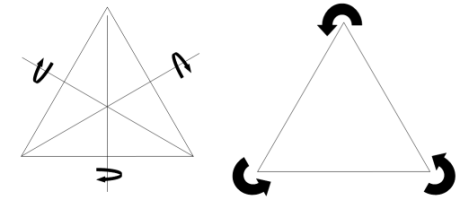In my previous post, I gave the definition of a group. In this post, I will identify some examples of groups. My objective for this post is to show that many different objects (not just numbers) fit the bill for a group, and so it may be easier to prove things for a group abstractly (that is, without any particular group in mind) using just the properties of the definition of a group.
Example 1: As in the previous post, the integers form a group under addition.
Proof: A general property of addition of integers is that the sum of two gives another. The operation can also be taken for granted to be associative. Previously, I identified 0 as the identity element, and the negative of an element to be its inverse.
(Non) Example: The integers under multiplication do not form a group.
Proof: The operation of multiplication is indeed a binary operation, and it is associative. The identity element is 1 because for every
. However, no element other than 1 itself has an inverse. Indeed, when multiplication is the operation, the inverse of
is
, but the only
for which this is an integer is
. Furthermore, 0 does not even have an inverse in any set of numbers since
. Hence
is not a group.
Example 2: To fix the previous problem, consider the set , that is, the set of all rational numbers (fractions) minus the number 0, with the operation of multiplication. I will leave it to the reader to verify that this does indeed form a group.
Example 3: Consider the set of all non-singular (that is, invertible) matrices, together with matrix multiplication. The reader familiar with matrix algebra will be able to easily show that these form a group.
Example 4: One can also form groups out of objects that aren’t necessarily numbers. For example, consider the symmetries of an equilateral triangle, as shown below in the picture.
The picture on the left involves flipping the triangle around the axis indicated. The picture on the right involves rotating the triangle, by either 120°, 240°, or 360°. Any of these operations will return an equilateral triangle in the same orientation as the original.
Call rotation by 120° the element , rotation by 240°
. Clearly, rotation by 360° leaves the triangle unchanged, so let’s call that
, the identity operation. Call the flip furthest left
, the middle flip
, and the right flip
. By labeling the vertices, we can then combine the operations to get a new orientation. For example, a rotation by 120° followed by a rotation by 240° gives a total rotation by 360°. That is,
. Notice that the operations in this notation are applied right to left – that is, first we applied
followed by
. The set with these operations has the “multiplication table” shown below:
The table is read by taking the row times the column. So for the row marked and the column marked
, the result is
. That is, rotating first by 120° and then flipping along the centerline of the result is the same as flipping the triangle about the
line.
One can check using this table that these operations form a group. Clearly, rotations and flips give another rotation or flip, so the operation is indeed a binary operation. The indentity is rotation by 360°, and each element does indeed have an inverse (for example, since
; this can be checked for each and every element). And the operations are associative, though to show this is left as an exercise to the reader.
One beautiful thing about groups is that a very broad spectrum of objects can be shown to exhibit the properties of a group. It is much more attractive, then, to show things about a group abstractly than it is to show it for a certain set of objects.
For example, notice that in each of the groups in the above examples only had one identity element. This is actually true of any structure that is a group. Hence, the following theorem.
Theorem: In a group, the identity element is unique.
Proof: Suppose that there are two identity elements, and
. Then by applying properties of the identity element, we have
Because there was no reference to integers with addition, rationals with multiplication, invertible matrices, or symmetries of a triangle, I have simultaneously proven that the identity element of each of these structures is unique! Indeed, I have shown it for the countless numbers of groups that one can construct. That is the power of working abstractly!
Next time I’ll start proving a few other useful properties of groups.

[…] What is a mathematical group? (Part 3) June 11, 2008 Posted by Kevin in Mathematics. Tags: abstract algebra, complex numbers, field, group theory, real numbers, rings, vector space trackback This will be my last post in this little series I’ve started on group theory. Here are parts one and two. […]
Pingback by What is a mathematical group? (Part 3) « Unused Cycles — June 11, 2008 @ 6:22 pm
[…] 1)(Part 2) (Part 3) Possibly related posts: (automatically generated)What is a mathematical group? (Part […]
Pingback by What is a mathematical group? (Part 1) « Unused Cycles — June 11, 2008 @ 6:25 pm